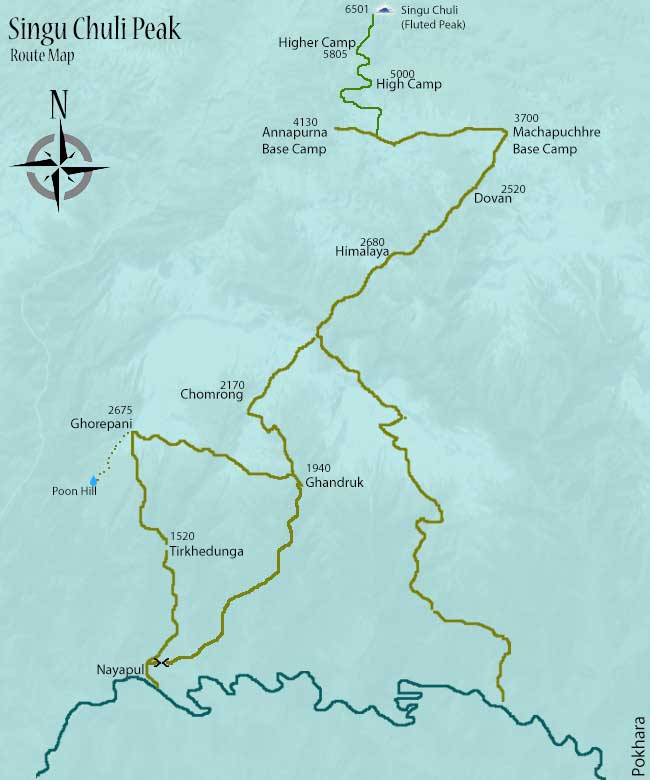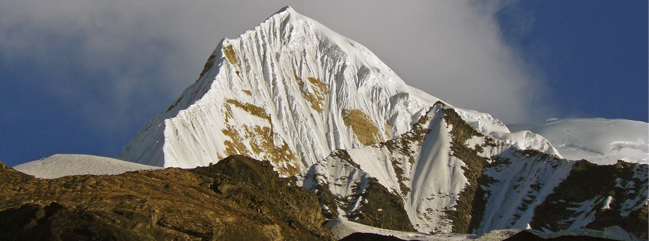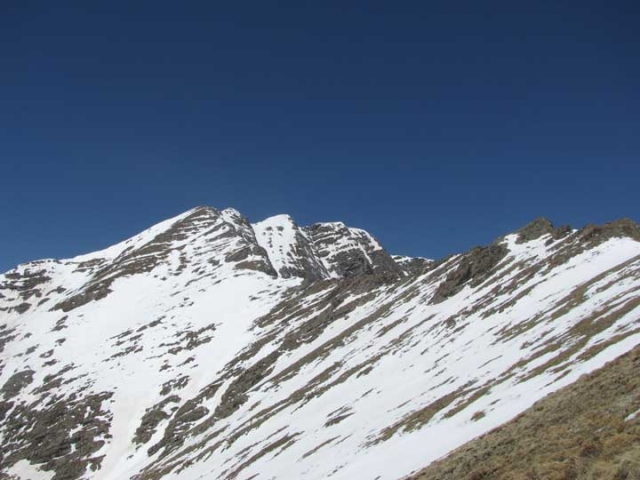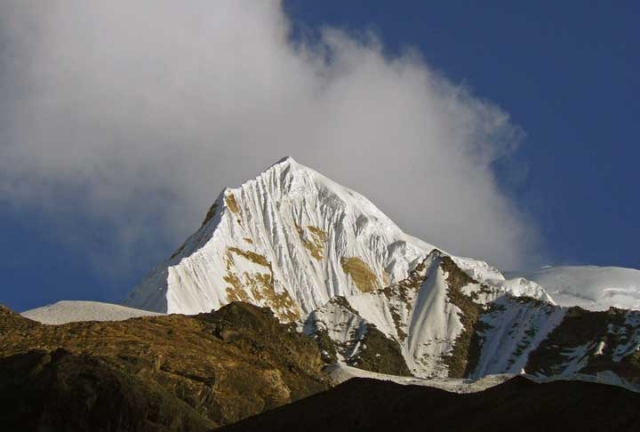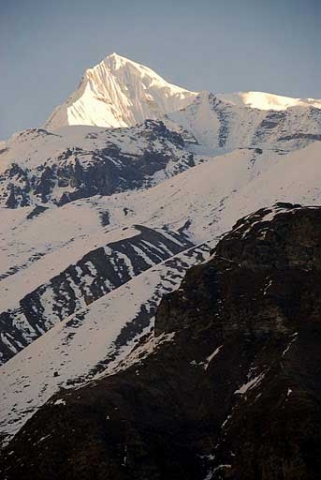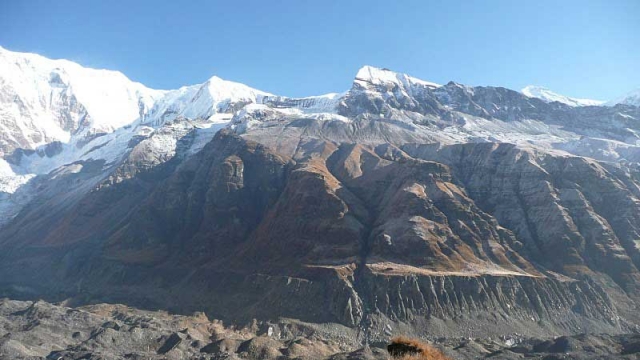Singu Chuli formerly known, as Fluted Peak is the 3rd highest amongst the “Trekking Peaks” of Nepal and situated in the Annapurna Sanctuary adjoined to Tharpu Chuli and across Hiunchuli trekking peaks placing a privileged, splendid amphitheatre of glaciers and nodes with, in background the mythical southern face of Annapurna. This peak is really an attractive and compared its beauty with India’s highest and probably the most beautiful peak, Nanda Devi but difficult, one that has proven too difficult for commercial climbing groups. Part of the problem is the steepness of the mountain but the final problem is the summit: a 100-foot high block of ice coated with snow. There are a number of different routes on the mountain with icefalls.
We have to do it by a trekking all carefully between cultivated hills nd terraces, marked out by prosperous villages Gurungs. Since the base Camp of Machhapuchhre, we will leave full north towards a less visited wild valley. We arrive at the base camp of Singu Chuli in six or seven days walk from the road head near Pokhara and place a base camp at around 4350m/ 14668ft and then place two higher camps one at 4,900m/16,000ft at the approach of North East Face and the other at 5,500m/18,000ft. on the North East Face of the mountain to before the summit is gained. Some vertical wall near the summit pose some technical challenge on this climb.
Day 01- Arrival at Kathmandu Airport.
There you will be met by our Airport Representative and transferred to hotel by private tourist vehicle. Overnight at hotel.
Day 02- Sightseeing around Kathmandu valley.
In the morning after breakfast at 9 AM, we host a Pre-Trip meeting at your hotel in Kathmandu and introduced your trek Leader/Guide mean time and it will provide an opportunity for individuals to ask questions about the your trek and to introduce you to other participants. This includes a final briefing and preparations for the trip.
PLEASE ADVISE US IF YOU WILL BE ARRIVING LATE AND ARE THEREFORE UNABLE TO ATTEND THE PRE-TRIP MEETING.
In THE PRE-TRIP MEETING All passengers MUST bring:
1. Passport.
2. Four copies of Passport size photos each.
3. Travel Insurance Policy.
4. A writing pen
5. Notepad.
After the Pre-Trip meeting and breakfast your sightseeing trip will start at 9.45 AM in the morning. We provide a private vehicle and professional tour guide. We visit Bodhnath Stupa, one of the biggest Buddhist shrines in the world, where we observe Buddhist monks in prayer in the monasteries surrounding the stupa. After Bodhnath Stupa we visit Pashupatinath, the most famous Hindu temple in the country, located on the banks of the holy Bagmati River. Here we see Hindu holy men (sadhus) meditating, pilgrims bathing and occasionally funeral pyres burning on the ghats. We also visit Bhaktapur Durbar Square, which is a collection of pagoda and shikhara – style temples grouped around a fifty-five-window palace of brick and wood. The attraction of the Bhaktapur Durbar Square is The Lion gate, The Golden gate, The Palace of fifty five windows, Art Galleries, The Statue of King Bhupatindra Malla.
The rest of our time in Kathmandu is free for further exploration and some last-minute shopping in Thamel area near by your hotel. Later, we are supplied with our Trek Pack and departure information for tomorrow. Overnight at hotel.
Day 03 – Drive to Pokhara (900 meters) 7 hours by tourist bus.
Trekking staff will come to your Hotel early in the morning at 6:30 am to pick you up then leaving around 7.30 am to Pokhara. Overnight at hotel.
Day 04 – Drive to Nayapul (1010meters) and trek to Tikhedunga (1570meters) 3 hours.
We begin our trek at Nayapul after 1 hour driving by private vehicle from Pokhara. After 15 minutes short walk along the bank of the Modi Khola, we reach Birethanti (1015meters) a large village that has many shops and teahouses. From there, the trail continues through the village. The trail follows the north bank of the Bhurungdi Khola. From there, the trail climbs steadily up the side of the valley to Hille at 1495m and after the short climb, we reach Tikhedhunga at 1570meters. Today’s walk offers a short and relatively easy day, during the journey which allows us to become used to the experience of trekking in Nepal. Overnight at guesthouse.
Day 05 – Trek to Ghorepani (2840meters) 5 hours.
Leaving Tikhedunga, we begin our journey with a steep climb to Ulleri. Ulleri is a large Magar village at 2070meters. The trail then continues to ascend more gently, through fine forests of oak and rhododendrons towards Banthanti at 2250meters. Then we trek towards Nangethanti at 2460m. After an hour of walking this brings you to Ghorepani at 2840meters. Overnight at guesthouse.
Day 06 – THike up to Poon Hill (3210meters) and trek to Tadapani (2610meters). 6 hours.
Today, very early in the morning, we start an hour hiking to Poon Hill at elevation of 3210meters, a brilliant spectacle; this vantage point provides an unobstructed view of sunrise over the high Himalayas. There we spend about 1 hour, we then return to Ghorepani we take a hot breakfast at the hotel then we trek to Tadapani (2610meters). Along the trail towards Tadapani, we make climb along ridges and through pine and rhododendron forests to Deurali (2960meters). After that we descend to the Banthanti, we then turn off to Tadapani. Overnight at guesthouse.
Day 07 – Trek to Chommrong (2140meters.) 5 hours.
The day starts with steep downhill through rhododendron forests. Leaving Tadapani, we descend steeply through forests and then the trail eases as we reach Gurjung which is the village of Gurung people, with an easy walk to Chommrong at elevation of 2140 meters. Overnight at guesthouse.
Day 08: Trek from Chhomrong to Bamboo (2340m.):
It takes about five hours, the trail descends on a stone staircase for the first one and half hour and crosses the Chhomrong Khola on a suspension bridge, then climbs out of the side valley. High above the Modi Khola on its west bank, the trail passes through the forests of bamboo, rhododendron and oak. Climbing further on a rocky you reach at Sinuwa, at 2350m. You trek gently through the forest and descend a long, steep stone staircase into deep bamboo and rhododendron forests.
Day 09: Trek from Bamboo to Deurali (3230m.):
It takes about five hours. You trek gently ascend through bamboo forests with varieties of rhododendron and oak trees. The first town you reach is Dovan (2630m.) where there are few lodges and camp sites. Now you pass through muddy trail. There is debris of avalanches except during winter season. After short trek, you reach at Himalayan Hotel (2900m.). Beyond it, the trail is steeply ascent up to Hinko Cave (3160m.), this named as a huge overhanging rock provides some protection against rain and avalanches. It takes approximately twenty five minutes through normally ascent path to reach Deorali (3230m.)
Day 10: Trek from Deurali to Annapurna Base Camp (4170 m.) via Machhapuchhare Base Camp (3820m.):
It takes about four hours from Deurali to ABC. The valley widens and becomes less steep and you can see the gates to the sanctuary from here. As the trail continues into the sanctuary, it crosses two avalanche tracks on a narrow trail that hurdles up against the cliffs. After short trek you will be at Bagar (3310m.), a meadow and some abandoned hotels. The normal trail follows the left side of the valley. Now the trail appears gently ascent until Machhapuchhare Base Camp (3820m.). Here you find almost 6 to 7 lodges. This is one of the places, where you can enjoy the view of Mount Hiunchuli (6441m.), Annapurna South (7229m.), Annapurna I (8091m.), Annapurna III (7555m.), Gangapurna (7454m.) and Machhapuchhare or Fish Tail (6997m.). The path follows through alpine meadow and after some distance your trails go gently up. After a short trek, you begin to approach Annapurna Base Camp (4170m.). You can see the views of several peaks at 360 degree from Annapurna Base Camp.
Day 11: Trek to Tent peak Base Camp (4400meters).
Day 12: Trek from Tent Peak Base Camp to Singha Chuli base camp.
Day 13: Trek from Base Camp to High Camp Singu Chuli.
Day 14: Summit Singu Chuli and back to Singu Chulu Base Camp.
Day 15: Trek back from Singu Chulu Base Camp to ABC.
Day 16: Trekking from Annapurna Base Camp to Dovan (2630m.):
It takes about five hours. It’s much easier going down. You should have no problem reaching Sinuwa from Annapurna Base Camp in a single day however we have choosen this place as some of trekkers may have problem on going down.
Day 17: Trekking from Dovan to Jhinudanda (1750m.):
It takes about six hours. The path is descent up to Bamboo passing through forests with varieties of rhododendron, oaks and bamboo plants. After Bamboo, the trail goes steeply up an hour and the trail is quite flat until Sinuwa. You trek gradually descend to the Chhumrong Khola and you have to follow stone staircase for almost an hour to reach Chhumrong. The last part of the trail is steeply down to Jhinudanda. From the town you should walk down for 20 minutes to reach Hot Spring at the bank of the Modi Khola. You can relax at Hot Spring.
Day 18: Trek from Jhinudanda to Pothana (1600m.):
It takes about five hours. The first part of the trek is descent and then appears through flat land until Himal Pani. You will find beautiful waterfall here. Beyond this town, the trail ascends gently crossing numerous streams and terraces. After short trek, you reach at Landruk (1640m.), a pretty big village inhabited by mixed community of Gurung, Magar and Brahmin as well. Now the trail gently ascends to Tolka (1850m.) and then ascent and level path to Bherikharka. From here, the trail goes steeply up to Deurali (2100m.) with a view of different mountain peaks. Now the trail gradually descends to Pothana passing through different oak forests. Pothana is a small town resided by Gurung, you can enjoy the wonderful views of various mountains from here.
Day 19: Trek from Pothana to Dhampus Phedi and drive to Pokhara:
It takes about three hours to Phedi. The Trekking trail is gently descent up to Dhampus, a village mainly inhabited by Gurung. Now you trek through flat land for some distance and steeply descend to Phedi. The trekking is ended now and it is a time to Car/Van to Pokhara.
Day 20- Drive to Kathmandu by tourist bus. 7 hours.
Overnight back at the hotel in Kathmandu by bus. If you are interested in continuing onto Chitwan Jungle Safari, River Rafting Adventure, Kathmandu Shopping Tour or Scenic Everest Flight. Overnight at hotel.
Day 21- Transfer to international airport for your final departure.
The trip ends, our Airport Representative will drop you to the Kathmandu international airport for your final flight departure from Nepal.
NOTE: The above information is a guide and standard template of what we provide. The trek can be customized at your request to accommodate your specific requirements.
NOTE: On adventure trips of this type, weather, local politics, transport or a multitude of other factors beyond our control can result in a change of itinerary. It is, however, very unlikely that the itinerary would be substantially altered; if alterations are necessary the leader will decide what is the best alternative, taking into consideration the best interests of the whole group. Where a change does occur, we do everything we can to minimize its effect, but we cannot be responsible for the results of changes or delays.
Q. How fit do I have to be and is trip for me?
A. Climbing Peak provides the most adventurous experience with spectacular scenery through remote glaciated valleys and passes. This trip requires you to have an above normal level of fitness which will assist with climbing Peak. Any person suffering from a pre-existing medical condition or diseases must seek medical advice before considering this trek. Whilst on the trek, it is common to experience some discomfort before being fully acclimatized.
To prepare for a strenuous trek you should begin training at least two to three months before your departure. As a guideline, an hour of aerobic exercise three to four times per week would be considered a minimum requirement. The best preparation is bushwalking involving relatively steep ascents and descents. If you can manage a couple of valley floor to ridgeline ascents per comfortable and able to enjoy the trek to the fullest. They are physically strong, sharp-witted and have an incredibly positive attitude towards a life that we would consider extremely tough. There is something about a trek in the Himalaya that draws you back time and time again. For keen walkers it is a paradise and even avowed non-walkers find that one foot just seems to follow the other, drawn by the appeal of what lies beyond.
Q. Will somebody come to pick me up at the Airport upon my arrival?
A. Yes, our Airport Representative will be there to greet you outside of Terminal Hall, he/she will be displaying an Kiwi Adventures Treks & Expedition sign with your name on it. Upon arrival, you will be transferred to your hotel.
Q. What sort of accommodation can I expect in Kathmandu and in trekking?
A. We use standard rooms from three/four star hotels in Kathmandu with breakfast included. Along the trekking routes teahouses/Lodges generally provide basic clean facilities with a mattress and a quilt or blanket. We can also offer you sleeping bags if needed (which need to return after the trip) but it is good idea to always have your own sleeping equipment. We usually provide single and double rooms as well as the occasional dormitory. The dining room is downstairs around a fire. All food will be cooked to order in the little kitchen. You should not enter the kitchen unless asked to do so.
Toilet Facilities – On trek, common toilet facilities are available at Tea Houses.
Q. What sort of food can I expect in trekking?
A. Most teahouses (lodges) cook a delicious range of mostly vegetarian fare. Pasta, tuna bakes, noodles, potatoes, eggs, dhal bhat, bread, soups, fresh vegetables (variety depends on the season) and even some desserts like apple pies, pancakes, and some interesting attempts at custard. You will find a lot of garlic on the menu because it assists with acclimatization – eat some every day. In many larger villages you may find some meat on the menu. You can always get hot chocolate, tea, and hot lemon drinks, as well as soft drinks, and treats like chocolate and crisps.
During the Camping, our export camping cook can prepare specially requested food if you advise. In any case, you will have similar fare to teahouses.
Each day dinner and breakfast are used to take in the same lodge you spend the night. Lunch will be taken on the way to destination.
Q. What sort of transportation you use?
A. Kiwi Adventures Treks & Expedition is all about providing you with local insights as well as adventure, with that in mind, where we think you will get more out of your holiday by using different means of transport that is what we do. Using a variety of private transport is an integral part of our Himalaya tours and enhances the experience!
We use private tourist vehicles for sightseeing, city tours and pickups. Depending on the group size we use cars, minibus, van, land cruiser. These small light vehicles are more manoeuvrable and flexible enabling us to take you through the Narrow roads of Nepal. All the vehicles are usually air-conditioned unless we are travelling in cooler areas.
Q. What is the best season for this trip?
A. The best time for this trip is October to November and March to May.
Q. What is the weather & temperature like in trekking?
A. Weather in the mountains is notoriously difficult to predict. At night it is generally cooler with the days being warmer, and in winter (January and February) it will be bit colder but the days can be quite beautiful and warm if the sun is out. There will be snow any time of year. It is also important to make sure that you can stay warm and dry in just about any conditions. Expect the unexpected! The temperature could be as high as 20 deg C to -15 deg C low.
Q. Can I charge my digital camera or other batteries on my trip?
A. These facilities will be available in most of the places in your hotel reception by paying some service charges. Remember to bring your adapters!
Q. Is there any communication while we are on trekking?
A. There are telephones in some villages along the trekking routes from which you can make international calls.
Q. Can I use credit cards in the places visit in trekking?
A. In most cities yes, to some extent, however once you leave those cities behind you will only need cash.
Q. How much additional money do I need per day?
A. In Kathmandu, you can allocate US$ 10 – 25 for a lunch / dinner. It’s all depends on your spending habits. US$10 to 20 US$ a day will be enough to buy bottles of water, chocolates and few drinks in trekking.
Q. Do I need to tip my guide and porters? How much would that be?
A. This is a difficult thing to judge. We have seen everything from 20USD to 1000 USD per person for guides and porters. Tipping is not required, but a small way to show your guides and local porters thanks for their help. The level of the tip should reflect the level of personal involvement with your guide.
Q. Is the water OK to drink? Do I need to bring purifying tablets/filter?
A. In most places bottled water is readily available. But it is important for you to drink normal water, so bring purifying tablets with you. During camping we provide boiled water to drink.
Q. Are the Kiwi Adventures Treks & Expedition staff insured?
A. Our company insures all our trekking staff, including guide, cook, Sherpa and porters.
Q. What essential documents do I need to bring with me on tour?
A. *Valid Passport – must be valid for up to 6 months after you return from your tour, keep a separate photocopy.
*Travel insurance, keep a separate photocopy
*Cash and Traveller’s Cheques, keep numbers and proof of purchase separate
*Flight tickets
*Emergency contact numbers for T/C’s, banks, insurance, family contacts.
Q. Can I add extra days to my trekking trip?
A. A trekking holiday should never be about making it to the final point quickly. Along your trek we can add days at your request with additional costs to cover guides, porters, accommodation and food.
Q. Do you use yaks/porters on the trek or do we carry all of our own gear?
A. Whilst on the trek, our porter will take care of your luggage. All you need to carry is your small day bag for your personal belongings like camera, water bottle, sun cream etc only.
Q. What opportunities will I have for shower along the trek?
A. In major places, we arrange guesthouse with hot shower. And in rest of the places, hotel water in bucket will be provided for shower; it would cost you extra about USD 5-8 per shower.
Cost Includes
• Airport / Hotel / Airport pick up & drop by private car / van / bus.
• Standard twin sharing accommodation in three/four star hotel in Kathmandu breakfast included.
• Guided city tour in Kathmandu by private car / van / bus.
• All your standard Meals as per itinerary during the trek and Climb.
• Hot drinks during camping (from Island epak base camp and above).
• Tea Houses / Lodges, Guesthouses and Tented accommodation during the trek.
• A government licensed English speaking Guide during the trek and climb.
• The required number of staff and Porters to carry your luggage during the trek.
• Food, accommodation, salary, insurance, equipment, medicine for all staff.
• Everest National Park permits.
• Singu Chuli Peak Permit fees.
• Garbage Deposit Fee.
• General Climbing equipment such as Rope, Ice Screw, Snow Bar etc.
• Airfare from Kathmandu – Lukla – Kathmandu including airport departure tax in Kathmandu and Lukla airport.
• Surface transfer from and to Kathmandu.
• All our government taxes.
• Official expense.
Cost Excludes
• Lunch and dinner whilst in Kathmandu.
• Your travel insurance (compulsory).
• International airfare and airport departure tax.
• Nepal entry visa, you can obtain a visa easily upon your arrival at Tribhuwan International Airport in Kathmandu. (Tourist Visa with Multiple Entry for 30 days can be obtained by paying US $ 40 or equivalent foreign currency. Similarly, Tourist Visa with Multiple Entry for 90 days can be obtained by paying US $ 100. You will also require 2 passport size photos.)
• Alcoholic, hot and cold drinks laundry.
• Personal trekking and Climbing Equipment.
• Tips for trekking staff. (Tipping is expected).
• Any others expenses which are not mentioned on Price Includes section.
